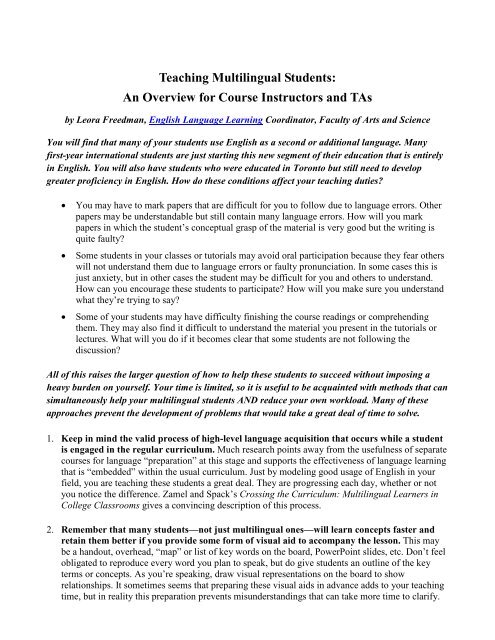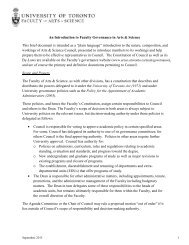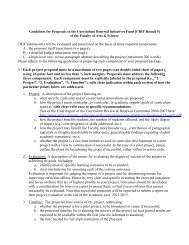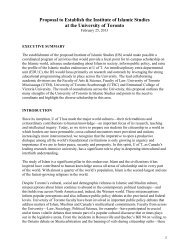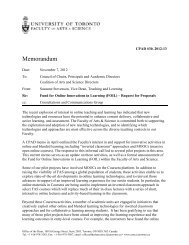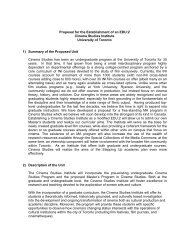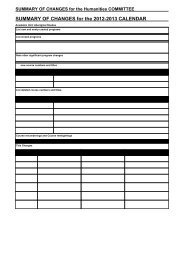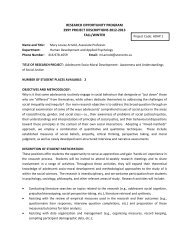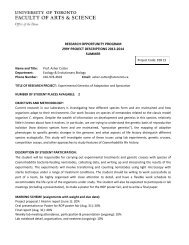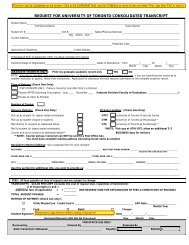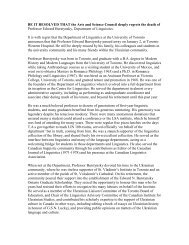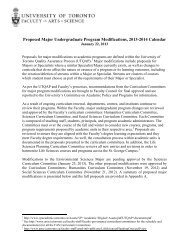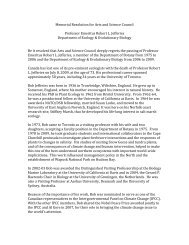Teaching Multilingual Students - the Faculty of Arts & Science ...
Teaching Multilingual Students - the Faculty of Arts & Science ...
Teaching Multilingual Students - the Faculty of Arts & Science ...
Create successful ePaper yourself
Turn your PDF publications into a flip-book with our unique Google optimized e-Paper software.
<strong>Teaching</strong> <strong>Multilingual</strong> <strong>Students</strong>:<br />
An Overview for Course Instructors and TAs<br />
by Leora Freedman, English Language Learning Coordinator, <strong>Faculty</strong> <strong>of</strong> <strong>Arts</strong> and <strong>Science</strong><br />
You will find that many <strong>of</strong> your students use English as a second or additional language. Many<br />
first-year international students are just starting this new segment <strong>of</strong> <strong>the</strong>ir education that is entirely<br />
in English. You will also have students who were educated in Toronto but still need to develop<br />
greater pr<strong>of</strong>iciency in English. How do <strong>the</strong>se conditions affect your teaching duties<br />
• You may have to mark papers that are difficult for you to follow due to language errors. O<strong>the</strong>r<br />
papers may be understandable but still contain many language errors. How will you mark<br />
papers in which <strong>the</strong> student’s conceptual grasp <strong>of</strong> <strong>the</strong> material is very good but <strong>the</strong> writing is<br />
quite faulty<br />
• Some students in your classes or tutorials may avoid oral participation because <strong>the</strong>y fear o<strong>the</strong>rs<br />
will not understand <strong>the</strong>m due to language errors or faulty pronunciation. In some cases this is<br />
just anxiety, but in o<strong>the</strong>r cases <strong>the</strong> student may be difficult for you and o<strong>the</strong>rs to understand.<br />
How can you encourage <strong>the</strong>se students to participate How will you make sure you understand<br />
what <strong>the</strong>y’re trying to say<br />
• Some <strong>of</strong> your students may have difficulty finishing <strong>the</strong> course readings or comprehending<br />
<strong>the</strong>m. They may also find it difficult to understand <strong>the</strong> material you present in <strong>the</strong> tutorials or<br />
lectures. What will you do if it becomes clear that some students are not following <strong>the</strong><br />
discussion<br />
All <strong>of</strong> this raises <strong>the</strong> larger question <strong>of</strong> how to help <strong>the</strong>se students to succeed without imposing a<br />
heavy burden on yourself. Your time is limited, so it is useful to be acquainted with methods that can<br />
simultaneously help your multilingual students AND reduce your own workload. Many <strong>of</strong> <strong>the</strong>se<br />
approaches prevent <strong>the</strong> development <strong>of</strong> problems that would take a great deal <strong>of</strong> time to solve.<br />
1. Keep in mind <strong>the</strong> valid process <strong>of</strong> high-level language acquisition that occurs while a student<br />
is engaged in <strong>the</strong> regular curriculum. Much research points away from <strong>the</strong> usefulness <strong>of</strong> separate<br />
courses for language “preparation” at this stage and supports <strong>the</strong> effectiveness <strong>of</strong> language learning<br />
that is “embedded” within <strong>the</strong> usual curriculum. Just by modeling good usage <strong>of</strong> English in your<br />
field, you are teaching <strong>the</strong>se students a great deal. They are progressing each day, whe<strong>the</strong>r or not<br />
you notice <strong>the</strong> difference. Zamel and Spack’s Crossing <strong>the</strong> Curriculum: <strong>Multilingual</strong> Learners in<br />
College Classrooms gives a convincing description <strong>of</strong> this process.<br />
2. Remember that many students—not just multilingual ones—will learn concepts faster and<br />
retain <strong>the</strong>m better if you provide some form <strong>of</strong> visual aid to accompany <strong>the</strong> lesson. This may<br />
be a handout, overhead, “map” or list <strong>of</strong> key words on <strong>the</strong> board, PowerPoint slides, etc. Don’t feel<br />
obligated to reproduce every word you plan to speak, but do give students an outline <strong>of</strong> <strong>the</strong> key<br />
terms or concepts. As you’re speaking, draw visual representations on <strong>the</strong> board to show<br />
relationships. It sometimes seems that preparing <strong>the</strong>se visual aids in advance adds to your teaching<br />
time, but in reality this preparation prevents misunderstandings that can take more time to clarify.
<strong>Teaching</strong> <strong>Multilingual</strong> <strong>Students</strong>: An Overview for Course Instructors and TAs 2<br />
3. Encourage all students to use effective reading strategies. Many students benefit from a brief<br />
“preview” <strong>of</strong> a text or its key terms. Point out <strong>the</strong> larger structure <strong>of</strong> <strong>the</strong> reading, focusing on<br />
headings, definitions <strong>of</strong> terms, and important moves in <strong>the</strong> argument. <strong>Students</strong> <strong>of</strong>ten get lost in <strong>the</strong><br />
details. If a multilingual student asks you for advice about getting through <strong>the</strong> reading, encourage<br />
him/her not to look up every word but to manage <strong>the</strong> available time so as to reach <strong>the</strong> end.<br />
Reassure <strong>the</strong> student that reading speed and comprehension improve with time, etc. You can <strong>of</strong>ten<br />
best help someone learn a language simply by providing encouragement.<br />
4. Try to give students <strong>the</strong> opportunity to write frequently and not necessarily for a grade. You<br />
can devise exercises that involve responding briefly to a critical question or summarizing <strong>the</strong><br />
reading—short pieces that you can go around and read/comment on as part <strong>of</strong> <strong>the</strong> session.<br />
Alternatively, students can share what <strong>the</strong>y’ve written with a small group. All students benefit from<br />
having to express <strong>the</strong>mselves like this, even if you don’t collect or mark <strong>the</strong> papers. (You could<br />
also collect <strong>the</strong>m and check <strong>the</strong>m <strong>of</strong>f as a participation mark, or just use a simple rubric as a<br />
response). Exercises like <strong>the</strong>se may also alert you to students who should be advised to take <strong>the</strong>ir<br />
longer assignments to <strong>the</strong>ir Writing Centre for fur<strong>the</strong>r targeted instruction on specific aspects <strong>of</strong><br />
writing: see www.writing.utoronto.ca/writing-centres.<br />
5. If your course has a policy allowing students to show you a rough draft <strong>of</strong> a longer paper,<br />
encourage <strong>the</strong>m to do so. Do not spend a great deal <strong>of</strong> time on a rough draft; look carefully at <strong>the</strong><br />
first 2-3 paragraphs, which will tell you whe<strong>the</strong>r <strong>the</strong> student has understood <strong>the</strong> assignment and has<br />
some sense <strong>of</strong> <strong>the</strong> necessary structure. Tell <strong>the</strong>m <strong>the</strong> purpose <strong>of</strong> <strong>the</strong> meeting is simply to determine<br />
whe<strong>the</strong>r <strong>the</strong>y’re on <strong>the</strong> right track. If <strong>the</strong>y’re not, give an explanation but do not start actually<br />
helping <strong>the</strong>m revise <strong>the</strong> paper. If <strong>the</strong>re are serious language errors, circle just some examples. For<br />
more individualized instruction in language use, students can visit <strong>the</strong>ir writing centre. Writing<br />
centres do not “edit” <strong>the</strong> entire paper, but can be asked to provide instruction in specific elements<br />
<strong>of</strong> organization, development, grammar, sentence structure, diction, etc. Keep your own<br />
discussions with students focused on how effectively <strong>the</strong>y’ve communicated course concepts<br />
6. Refer students who are having difficulty reading, writing, or speaking to <strong>the</strong> network <strong>of</strong><br />
support for English Language Learners. Undergraduate students in <strong>Arts</strong> and <strong>Science</strong> can<br />
participate in <strong>the</strong> Reading eWriting project online or <strong>the</strong> Communication Cafes, which are drop-in<br />
sessions focusing on academic English. Similar programs are available in o<strong>the</strong>r divisions<br />
(including one for graduate students): see www.writing.utoronto.ca/faqs/english-as-a-secondlanguage.<br />
(These programs don’t provide individual consultation on papers, though—that’s <strong>the</strong><br />
mandate <strong>of</strong> <strong>the</strong> writing centres.)<br />
7. Remember that educational backgrounds vary widely. A student may not understand a reading<br />
or an assignment for cultural reasons (i.e. a lack <strong>of</strong> background knowledge, or a variance in<br />
assumptions). Many educational systems do not emphasize critical thinking, so this may be a new<br />
skill for some <strong>of</strong> your students. In tutorials, it is helpful if you model <strong>the</strong> kind <strong>of</strong> analysis you want<br />
students to do and give <strong>the</strong>m a chance to practice it orally before <strong>the</strong>y have to write. Remember<br />
that many students are coming to English as a third or fourth language, which is harder for many<br />
people than a second language.<br />
8. <strong>Students</strong> are more likely to speak in smaller groups. To maximize participation, you can divide<br />
your class into smaller groups <strong>of</strong> 2-6 students, depending on <strong>the</strong> task, and have <strong>the</strong>m discuss an<br />
issue with each o<strong>the</strong>r. One person can be designated to “report” back to <strong>the</strong> class as a whole. You’ll<br />
be amazed at how many more people will speak if you use this method.
<strong>Teaching</strong> <strong>Multilingual</strong> <strong>Students</strong>: An Overview for Course Instructors and TAs 3<br />
9. Model effective English. Make sure your own expression is very clear and precise, both orally and<br />
in writing. Use large, clear handwriting on papers and on <strong>the</strong> board.<br />
10. If you receive a paper that would fail due to language issues, consider giving <strong>the</strong> student a<br />
second chance. (TAs should follow course policy on this issue.) Particularly at <strong>the</strong> beginning <strong>of</strong><br />
<strong>the</strong>ir studies, students may not be aware <strong>of</strong> <strong>the</strong> resources available to <strong>the</strong>m or <strong>the</strong> gap between <strong>the</strong>ir<br />
level and <strong>the</strong> university’s expectations. It can be difficult and time-consuming for you to mark a<br />
paper that is disorganized and contains many errors. If course policy permits, you may be able to<br />
tell <strong>the</strong> student that a paper is not acceptable and that he/she must turn in a revised version after<br />
working with an instructor at a writing centre.<br />
11. If you see plagiarism, remain cool and objective. Your student may indeed have taken <strong>the</strong> work<br />
<strong>of</strong> ano<strong>the</strong>r student or copied an essay from <strong>the</strong> Internet. However, most plagiarism cases are not as<br />
clear-cut as <strong>the</strong>se. Many <strong>of</strong> our multilingual students come from educational backgrounds that have<br />
not provided instruction in how to use research sources according to a North American protocol.<br />
These students have no sense <strong>of</strong> <strong>the</strong> concept <strong>of</strong> “ownership” that we attach to published sources<br />
and have <strong>of</strong>ten learned English through memorizing texts. Try to prevent plagiarism by letting<br />
students know that proper referencing is essential. For fur<strong>the</strong>r advice and explanation, refer <strong>the</strong>m to<br />
relevant files on <strong>the</strong> Writing at U <strong>of</strong> T website (www.writing.utoronto.ca/advice/using-sources),<br />
and <strong>the</strong> group workshops and individual instruction <strong>of</strong>fered by <strong>the</strong>ir writing centres. For an<br />
enlightening discussion <strong>of</strong> plagiarism and multilingual students, see Belcher and Hirvela’s Linking<br />
Literacies: Perspectives on L2 Reading-Writing Connections.<br />
12. In your marking, it may be helpful to make a distinction between errors that obscure<br />
meaning and those that simply distract <strong>the</strong> reader. You don’t need to apologize for <strong>the</strong> fact that<br />
English is <strong>the</strong> language <strong>of</strong> instruction at U <strong>of</strong> T and that students must write very well in English in<br />
order to get an “A.” However, you can also mark holistically, taking into account <strong>the</strong> degree <strong>of</strong><br />
depth, complexity, and sophistication in <strong>the</strong> analysis; overall organization; and use <strong>of</strong> research.<br />
Sometimes <strong>the</strong>se attributes may outweigh language errors to <strong>the</strong> point where you feel justified in<br />
giving a good mark. Even if a paper deserves a low mark for serious language errors, it is<br />
validating for <strong>the</strong> student if you respond to <strong>the</strong> ideas in <strong>the</strong> paper and acknowledge <strong>the</strong> attempt to<br />
communicate. In any case, you can simply circle or underline errors ra<strong>the</strong>r than correcting <strong>the</strong>m or<br />
rewriting sections <strong>of</strong> <strong>the</strong> paper; this saves time and is <strong>of</strong>ten just as helpful in <strong>the</strong> long run.<br />
Useful Links:<br />
• The <strong>Faculty</strong> section <strong>of</strong> <strong>the</strong> website Writing at <strong>the</strong> University <strong>of</strong> Toronto at www.writing.utoronto.ca/faculty<br />
contains many o<strong>the</strong>r valuable advice files on aspects <strong>of</strong> teaching writing, including assignment design and<br />
commenting on student work. See <strong>the</strong> ELL tab in that section for more detailed advice files on specific issues<br />
around reading and grading, including one on helping students with reading comprehension.<br />
• The Resources for <strong>Students</strong> section <strong>of</strong> <strong>the</strong> ELL website at www.artsci.utoronto.ca/current/undergraduate/ell <strong>of</strong>fers<br />
downloadable student handouts outlining specific strategies for listening, reading, and interpreting texts and<br />
visuals. Undergraduates in <strong>Arts</strong> and <strong>Science</strong> can also find information about <strong>the</strong> ELL summer course,<br />
Communication Cafés, and online Reading e-Writing activities.<br />
• All students can consult <strong>the</strong> page www.writing.utoronto.ca/faqs/english-as-second-language for annotated lists <strong>of</strong><br />
o<strong>the</strong>r campus programs (including longstanding ones at UTSC, SGS and <strong>the</strong> Centre for International Experience)<br />
and links to relevant books and online learning activities.<br />
____________________________________________________________________________________________<br />
Prepared 2012 by Leora Freedman, English Language Learning Coordinator, <strong>Faculty</strong> <strong>of</strong> <strong>Arts</strong> and <strong>Science</strong>,<br />
for <strong>the</strong> <strong>Faculty</strong> section <strong>of</strong> <strong>the</strong> website Writing at <strong>the</strong> University <strong>of</strong> Toronto: www.writing.utoronto.ca.


